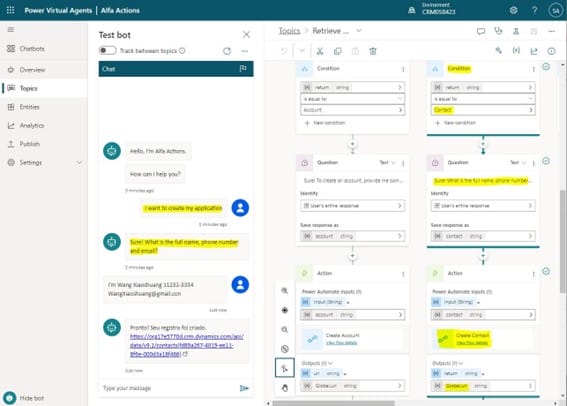
Boosting your projects with Azure Open AI – ChatGPT
Artificial Intelligence (AI) is no longer confined to science fiction; it has been spotlighted and caught organizations’ attention. As consultants, it is essential to recognize this growing presence and take the first steps toward implementing AI´s transformative capabilities.
In this blog, we will explore tips for getting started with Azure Open AI implementation and examples of using these features in a simple flow of obtaining relevant data.
Prerequisites for a good understanding of this blog
- A desire to learn.
- Minimum knowledge of Omnichannel for Customer Service and Cloud Flow.
First step: Understanding the landscape
The first step in implementing AI is to have a solid understanding of the landscape and a clear vision of the desired outcomes, as it still needs accurate and well-defined human information to generate relevant responses.
As such, consultants should assess the use cases and customer pain points where AI can significantly impact. In addition, one cannot forget to analyze the users´ perspective to ensure that AI understands their intentions accurately to respond with empathy, clarity, transparency, and respect for their privacy.
Guiding AI interactions with purpose and precision
To understand the implementation of activities of an AI interaction, let´s define the following macro-objective and flow.
Macro-objective: “Provide the customer with a service channel via chat where the customer can request, in natural language, a personal or business registration, or even register their interest in a product or service.”
Basic flow configuration in Power Virtual Agent:
- Chatbot greets the customer and asks how it can help him.
- The customer makes their request.
- Chatbot identifies whether the intention is related to Accounts, Contact, Opportunity, or None of the options.
- If it´s an Account, it asks for the Name, ID, and e-mail. If it is a Contact, it asks for Name, telephone, ID, and e-mail.
- The Customer provides the requested information.
Chatbot identifies the relevant data to create the record in the Dataverse and returns the records’ URL.

Fig 1: Basic flow configuration in Power Virtual Agent (Greeting and Request type acknowledgment)
In a non-NLP (Natural Language Processing) scenario, clients would fill in rigid templates or redefined options, allowing for easy and structured data collection.
On the other hand, an NLP approach allows customers to express their requests and queries in their own words, and the system can intelligently process and understand the customer´s request. However, how does it extract relevant structured data?
Our first reaction is to forward the customer´s request to ChatGPT, but we would see a high probability of getting an out-of-context analysis. Thus, the suggestion is to use the tips mentioned in the article “Unlocking the intelligence of Azure Open AI – ChatGPT” and forward a reformulated request preceded by context, conditions, sub-questions, and the desired response format.

Fig 2: Example of context and conditions added to the original customer request for better intent classification.
Conversation Flow example
In our scenario, the Chatbot greets the customer and asks how we can assist. The customer makes the request, and we trigger the flow to complement the request to obtain the most coherent intent and suitable format.

Fig 3
The user´s intention to register the company
Targeting the response format (Account, Contact, Opportunity, or None) makes identifying the following Chatbot action more efficient!

Fig 4: ChatGPT response after identifying the Intent type.
In the text example, the flow identifies a contact´s registration intention, and the chatbot instructs the customer to provide their Name, phone number, and e-mail. Note that the flow does not provide a rigid model for capturing data; the customer can enter their data.

Fig 5: Contact’s registration intention
Like the intent identification flow, we trigger the flow where we complement the request to get only the necessary data in the most suitable format. In this case, a JSON object will help us in the following actions to validate the content or create a new contact in the Dataverse.

Fig 6: Resource used to obtain relevant data for creating a contact record.
Continuous improvement is an ongoing journey
Implementing AI solutions requires an agile mindset encompassing business knowledge, experimentation, creativity, and continuous improvement. Testing and defining AI interactions should not be seen as a one-time task but rather as an ongoing journey of constant improvement.
Consultants should encourage the business to adopt an iterative approach, starting with small-scale implementations and gradually expanding as they gain insights and refine their strategies.
AI is not just a tool – it´s a game-changer
Improving customer experiences and increasing operational efficiency with the power of AI requires crafting a clear implementation roadmap that will rely on collaboration across teams from IT to marketing and customer service to ensure a comprehensive and cohesive approach. Engaging all areas of the customer is crucial to getting insights into their needs and challenges, enabling the development of curated and reliable AI solutions.
For us, embracing this transformative technology means facing the need to adapt and evolve, requiring a unique mindset and skill set. Creating user experiences that provide personalized and intuitive interactions is an art that requires careful planning and consideration. Still, it is an unprecedented opportunity and challenging endeavor to confront AI as a game-changer and take the first steps toward enhancing customer experience.






